摘要
高分辨率的图像因像素密度较高而能为数字图像处理提供较多重要的细节
信息,为图像后期的处理作准备。然而,在现实生活中,由于成像设备、光照等
诸多条件限制,获取的图像分辨率往往都较低。因此,如何有效地提高获得图像
的质量成为图像处理一项十分关键而重要的任务。
在图像采集系统中,光学传感器的分辨率不能完全满足一些特殊场景的需
求,而且成像过程受加性噪声及透镜点扩散函数(PSF,Point Spread Function)的影
响,因此,图像成像只能获得降质的低分辨率图像,此时,超分辨率图像复原在
嵌入式机器视觉系统中起到举足轻重的作用。本文针对超分辨率图像复原技术中
的插值技术及超分辨率图像复原技术在硬件中实现进行了较为深入的研究,同时
提出了具有创新性的插值算法。
鉴于图像超分辨率复原技术所存在的诸多问题,本文进行了详细的研究和实
验分析,主要完成了以下几个方面的工作:
1.详细地介绍了图像超分辨率复原技术的国内外研究现状,描述了复原算
法包含的灰度变换、二值化、插值放大、滤波去噪、小波变换等基本环节,并对
图像超分辨率复原与图像恢复、图像增强和图像融合之间的区别进行了讨论。
2.重点分析了传统的线性插值方法,包括理想插值、最近邻插值、双线性
插值、四点双三次插值,分析了以上插值算法上的不足以及基于统计理论的图像
超分辨率算法不便于硬件实现这些特点,提出了一种算法复杂度低于双三次插值
算法,而处理效果优于双三次插值算法的基于图像边缘的插值算法,从而有效地
改善了图像边缘的效果。
3.描述了图像处理技术中几种常见的去噪方法,并进行了差异比较,提出
一种基于中值滤波和小波软阂值相结合的去噪方法,试图为后面的直径测量和计
算提供更为清晰的源图像以保证测量的精确度。
4.在硬件上对图像超分辨率算法进行实现,对图像进行了实验仿真,并对
单晶硅的非接触测量进行了简单的介绍,此外对算法进行优化,证明了该算法的
有效性具有一定的实用性。
�
5.对本文工作进行了总结,并为复原技术的后续工作提出了建设性的方案。
关键字:超分辨率复原,自适应图像插值,小波变换,滤波去噪,优化
�
ALbStl?aCt
The high-resolution images proVide more details for t11e digitalimage processing
because its higher pixel density,and prepares f.or image post—processing.HoweVer,
due to the limitations of tlle imaging equipment,lighting and other conditions,the
image res01ution is oRen loW.So,how to efrectively impr0Ve the image qualit),
becomes a very critical and inlportaIlt task in the image processing.
Image Supe卜res01ution techn0109y is one of the primary means to improVe t11e
image resolution.In t11e image acquisition system,the optical resolution of the sensor
can not mlly meet the special needs of the scene,by也e innuence of the additiVe
noise and the lens point spread矗mction(PSF,Point Spread Function)in dle imaging
process,therefore,也e image imaging can‘only obtain low·resolution images of low
quality.In this case,super-resolution image restoration plays a decisiVe role in the
embedded machine vision system.In mis paper,tlle inte印01ation teclmique in a
super.resolution image restoration techniques and supe卜resolution image restoration
techniques implemented in haurdwaure to conduct a more in—deptll research,innoVatiVe
inte印01ation algoritllm.
In view of the many problems that
exists in the image supe卜resolution
restoration techniques,tllis paper c枷ed out a detailed study and experimental
a11alysis,mainly to cornplete me work of the f01lowing aspects:
First,me detailed description of Image Super_resolution tecllllology research
status,describes me restoration algoritllm contains gray transfom basic aspects
binarization zoom inte印olation filter
denoising, waVelet traIlsform
aJld image
supe卜resolution The rate of recovery and image restoration,the dif.ference between
the image e1111aJlcement a11d image msion are discussed.
Second,me focus of analysis of t11e traditional linear inte印olation methods,
including me idealinte印olation,nearest nei曲bor inte叩olation,bilinear inte印olation,
fourIpoint
bi.cubic
inte印olation, supe卜res01ution image obtained by low。order
imerpolation method for linear inte印olation function result is not satisfactory,hi曲
order inte印01ation method of hi曲complexity,aJld hardware to achieVe these
characteristics, proposed
an
algoritluIl complexity
than
bicubic
inte印olation
algorithm,and handle better than bicubic interp01ation algo“thm based on the
lV
�
statistical
tIleory of image super-resolution algorithm is not eaSy inte印olation
algoritllm based on也e edges of山e image,t11us e饪-ectiVely iII】lproviIlg me ef绝ct of the
edges of the image.
Then describe seVeraLl common image processing technology denoising method,
and廿le dif.ferences in comparison,proposed a combination of a median filter and
waVelet soR t11reshold denoismg memod,diaIneter measurement and calculation of
t11e back clearer of tlle source image,
Image supe卜resolution alg嘶也m implemented in hardware,也e experimental
simmation of the image, and monocrystalline non—contact measurement siInple
in仰duction,in addition to optimize image super-res01ution algori幽m,and proVe tllat
tlle algorithIn is e酋fectiVe has practicabili哆.
ms work is s砌【marized a11d constmctiVe for nle recoVq of me f01low—up
work ofⅡ1e techllical progr锄.
1(ey words:
super-resolution recoVe巩 adaptive image inte印ola石on, waVelet
transfonn,filtering noise,optimizing
V
�
目录
摘要…………………………………………………………………………………………………l
Abstract………………………………………………………………………………………………………………………….IlI
目录………………………………………………………………………………………………..V
第一章绪论……………………………………………………………………………………….1
1.1课题研究的背景和意义…………………………………………………………………l
1.2国内外研究现状…………………………………………………………………………2
1.3研究内容及章节安排……………………………………………………………………4
第二章图像超分辨率复原系统架构…………………………………………………………….6
2.1描述…………………………………………………………………………………………….6
2.1.1基本概念………………………………………………………………………….6
2.1.2基本模型………………………………………………………………………….8
2.2图像超分辨率复原基本环节……………………………………………………………9
2.2.1灰度变换和二值化……………………………………………………………….9
2.2.2边缘检测…………………………………………………………………………1 0
2.3本章小结………………………………………………………………………………..1 3
第三章超分辨率图像复原中插值方法的研究…………………………………………………14
3.1常用差值方法…………………………………………………………………………一14
3.1.1最近邻域值………………………………………………………………………l 4
3.1.2双线性插值………………………………………………………………………1 4
3.1.3双三次插值………………………………………………………………………1 5
3.2本文提出的边缘自适应双线性差值方法……………………………………………..1 6
3.2.1权值和方向选择…………………………………………………………………17
3.3实验结果及分析………………………………………………………………………..19
3.4本章小结………………………………………………………………………………..22
第四章滤波处理在超分辨率图像复原中的研究………………………………………………23
4.1图像去噪技术的发展现状……………………………………………………………一23
4.2常用图像去噪算法……………………………………………………………………一24
4.2.1均值滤波…………………………………………………………………………24
4.2.2中值滤波…………………………………………………………………………25
4.2.3维纳滤波…………………………………………………………………………25
4.2.3小波滤波…………………………………………………………………………26
4.3本文提出的一种基于中值滤波和小波软阈值滤波的去噪方法………………………27
4.3.1小波分解和重构原理……………………………………………………………27
4.3.2基于小波变换及小波软阈值的去噪方法………………………………………28
4.3实验分析………………………………………………………………………………..29
4.4本章小结………………………_………………………………………………………29
第五章图像超分辨率复原的DsP实现及单晶硅无接触直径测量…………………………..30
5.1 DSP处理器………………………………………………………………………………30
5.1.1聊s320C64x系列DSP的性能特点……………………………………………30
5.1.2刑S320C64x系列DSP的软件集成开发环境介绍……………………………30
VI
�
5.2图像超分辨率复原的DsP实现……………………………………………………….3l
5.2.1代码移植…………………………………………………………………………3 1
5.2.2程序优化…………………………………………………………………………3 1
5.3单晶硅无接触直径测量方法…………………………………………………………..34
5.4本章小结………………………………………………………………………………..36
第六章总结与展望………………………………………………………………………………37
6.1本文总结………………………………………………………………………………..37
6.2工作展望………………………………………………………………………………..37
参考文献………………………………………………………………………………………….39
致谢……………………………………………………………………………………………………………………………….43
攻读学位期间发表的学术论文及科研成果…………………………………………………….44
VII
�
英文缩略语表
Point-Spread Function
H神Resolution
Digital signaI Processing
Non Ma)【imum Suppression
Code Comp6ser Studio
Meall Square Error
点扩散函数
高分辨率
数字信号处理
非极大值压抑算法
代码调试器
均方误差
PSF
HR
DSP
NMS
CCS
MSE
VIIl
�
上海师范大学硕士学位论文
第一章绪论
第一章绪论
1.1课题研究的背景和意义
’评价图像质量重要的一个方面就是图像的分辨率,在数字图像处理技术应用
中,获得高分辨率(HR,Hi曲Resolution)图像对于图像处理结果的精确度至关
重要。高分辨率图像能在各种场合以及应用中提供更多关键的细节信息,关键因
素是图像内的像素密度较高。例如:医生依靠高分辨率图像能够快速准确地诊断
出病情;卫星依靠高分辨率图像可以轻易地分辨两个相似目标。此外,高分辨率
图像的应用还可以改善计算机视觉领域模式识别的性能。从20世纪70年代起,
cMOS和cCD图像传感器已经被广泛用于数字成像设备系统。虽然在~定程度上
这些传感器能够满足大多数成像要求,但是无法满足在一些特殊场合下特定的精
度。
利用传感器制造技术中的减小像素尺寸是提高图像分辨率最直接的方法。但
是会导致像素尺寸减小、单位面积通过的光随之减少等等不良后果,而且产生的
散粒噪声会导致图像质量的严重下降。因此,通过图像像素尺寸的减小来提高图
像空间分辨率受到了一定的限制。
增大传感器芯片尺寸是提高图像空间分辨率的另一种方法,这种方法产生的
结果会导致电荷容量的增大。较大的电荷容量不利于提高电荷的传输速度,所以
此方法被认为是无效的。高精度光学成像设备的高额成本也是许多涉及高分辨率
成像的商业应用中需要考虑的重要因素。
此外,图像超分辨率技术在众多电子应用领域更加显示出其重要性。图像超
分辨技术在各种领域的应用具体描述如下:
1.在遥感领域方面,当卫星周期性地沿其轨道运行时,只有在最靠近地点
的时候获得的图像分辨率最高,但是由于卫星有自己的高度而且天气原因和大气
污染的干扰,拍摄的图片大多数不能满足应用要求。因此可以利用超分辨率技术
对其进行处理,大幅度提高图像分辨率,从而提高卫星的识别能力和识别精度。
2.在公共安全方面,现有的公共安全视频监控系统无法满足社会的需要,
原因是监控设施的性能和技术手段以及获取的图像质量。因此,通过利用监控系
1
�
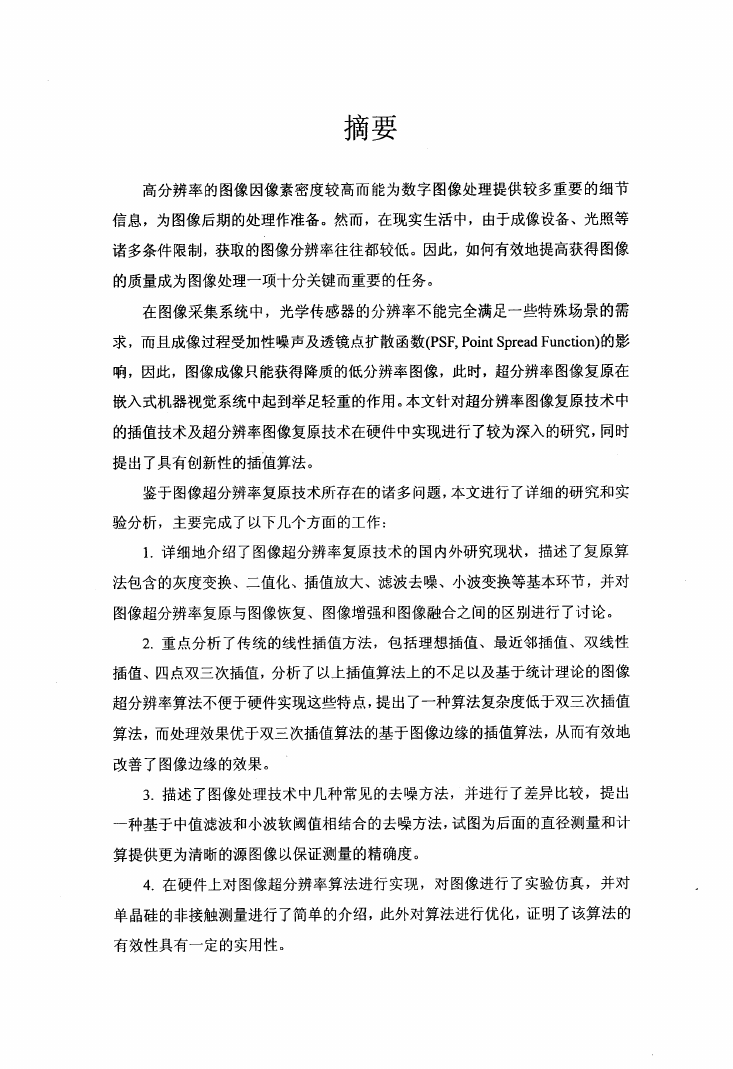

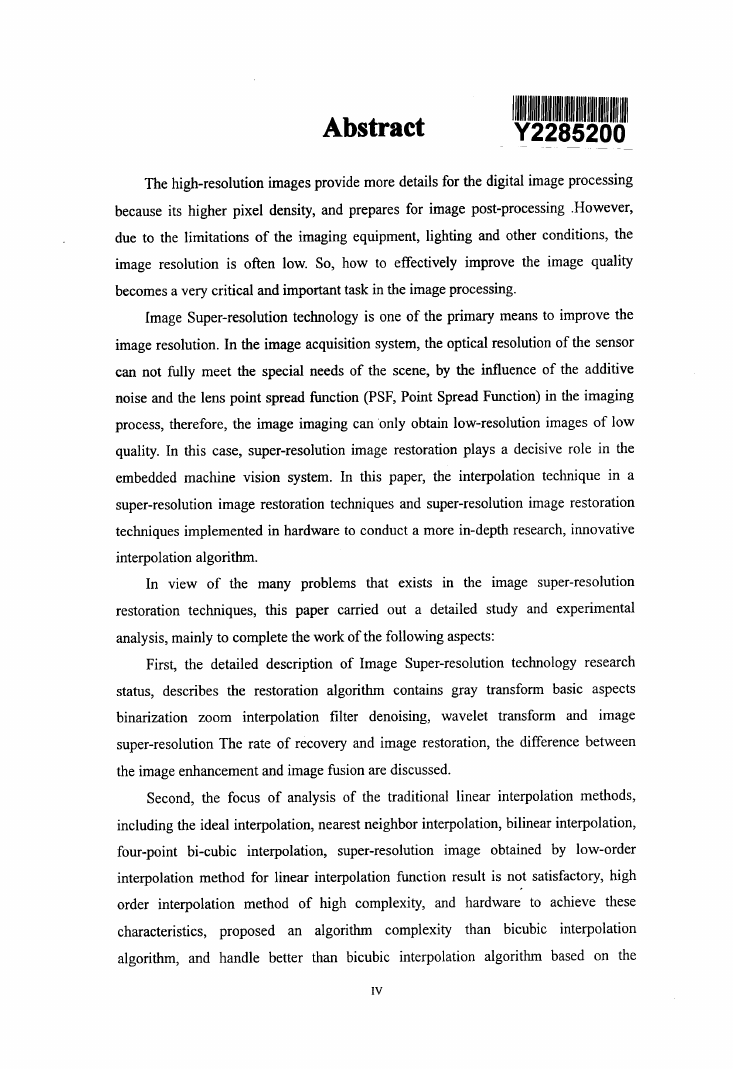
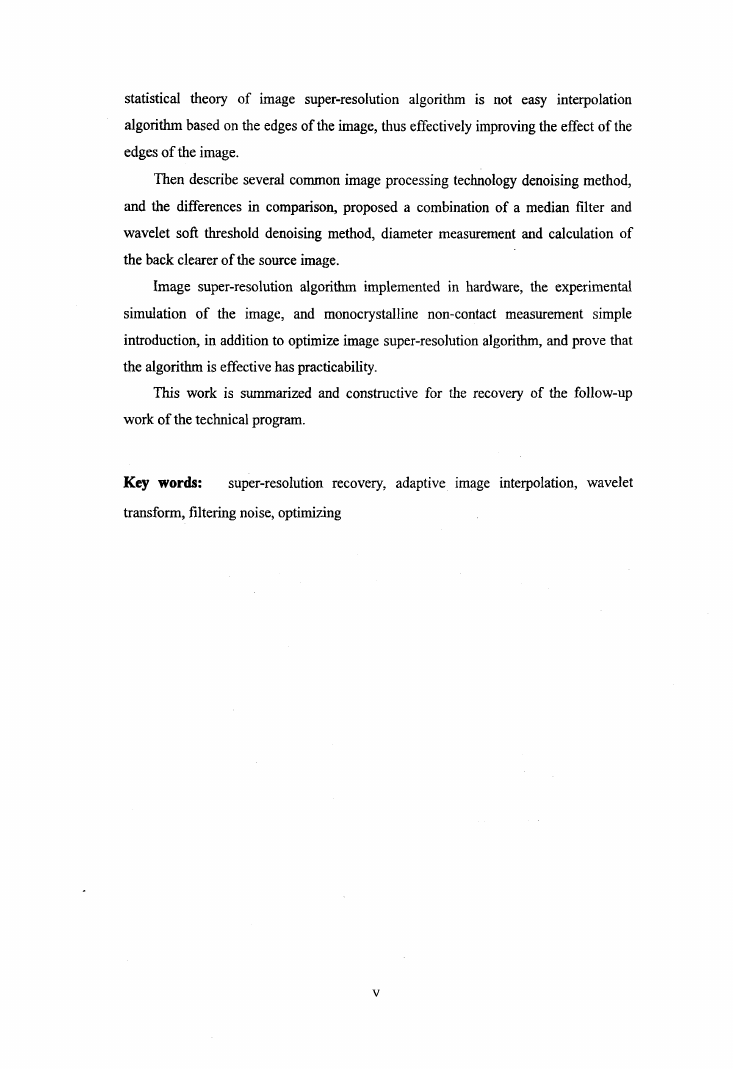
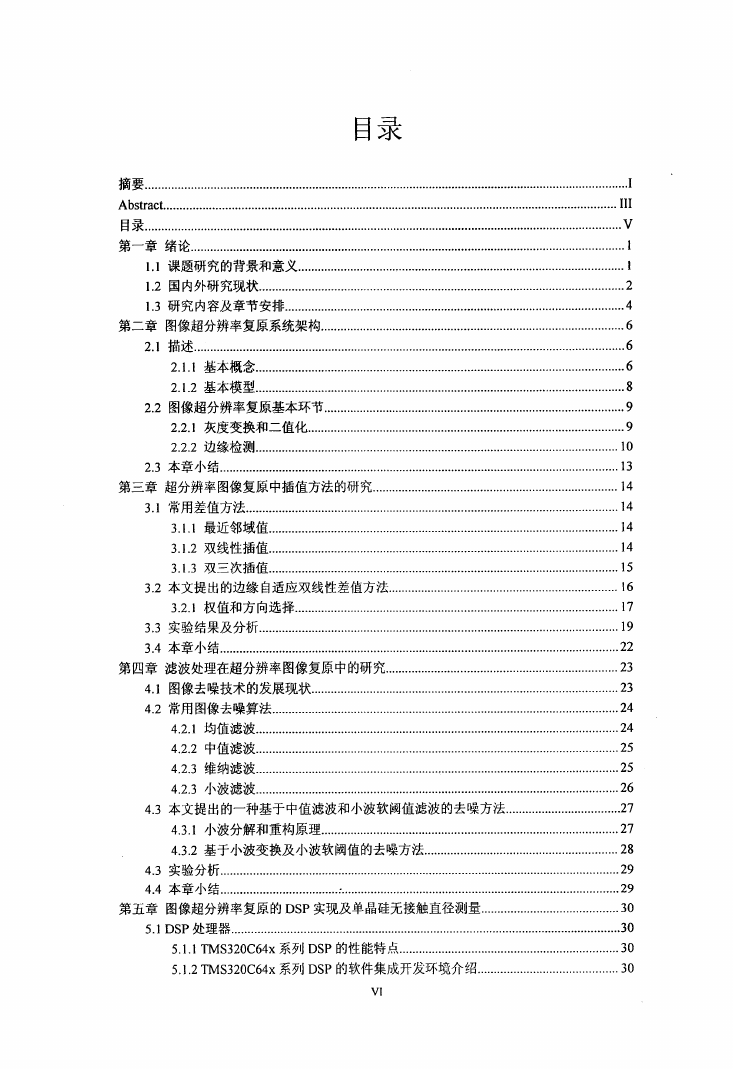
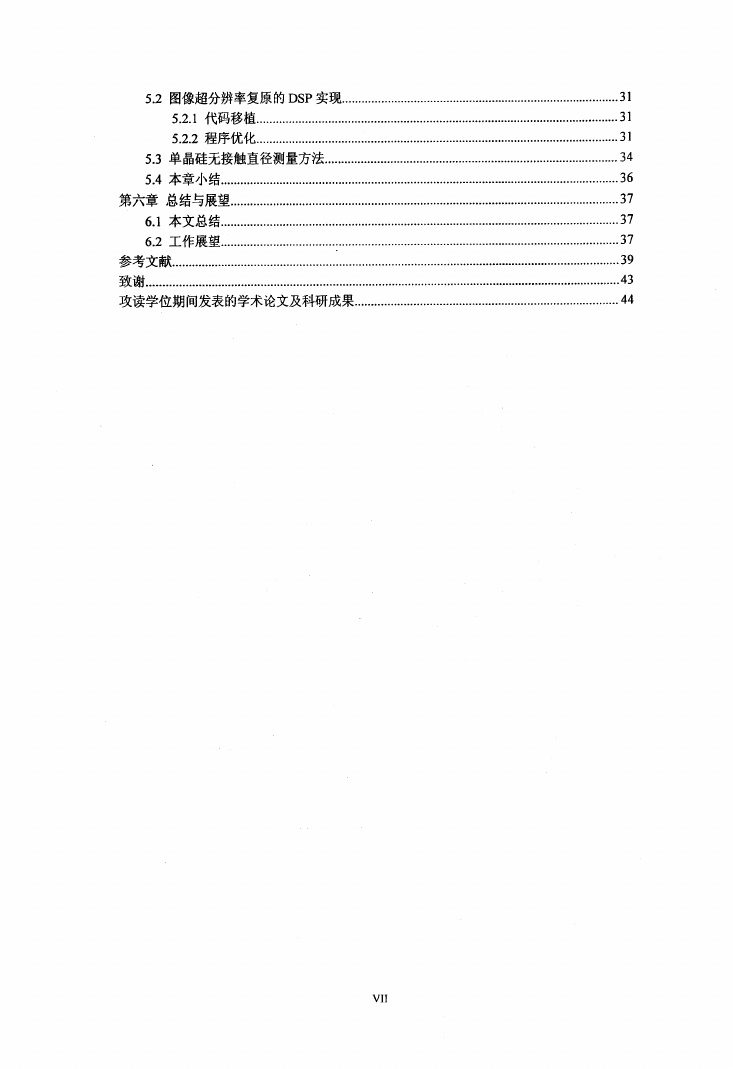
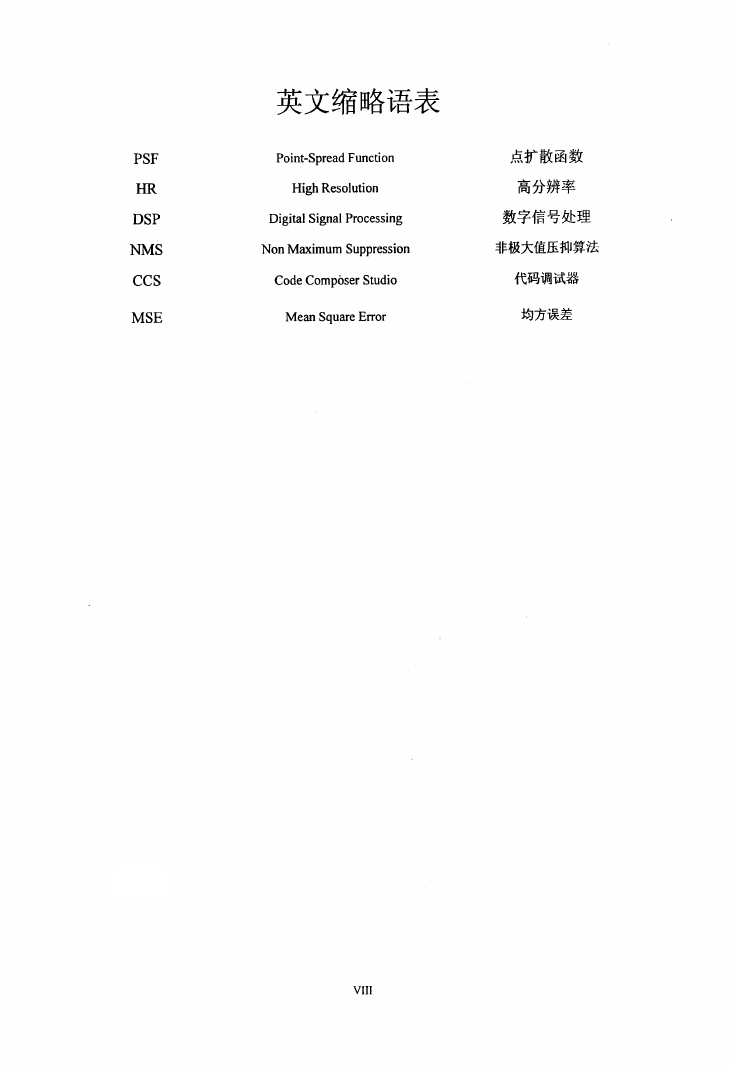
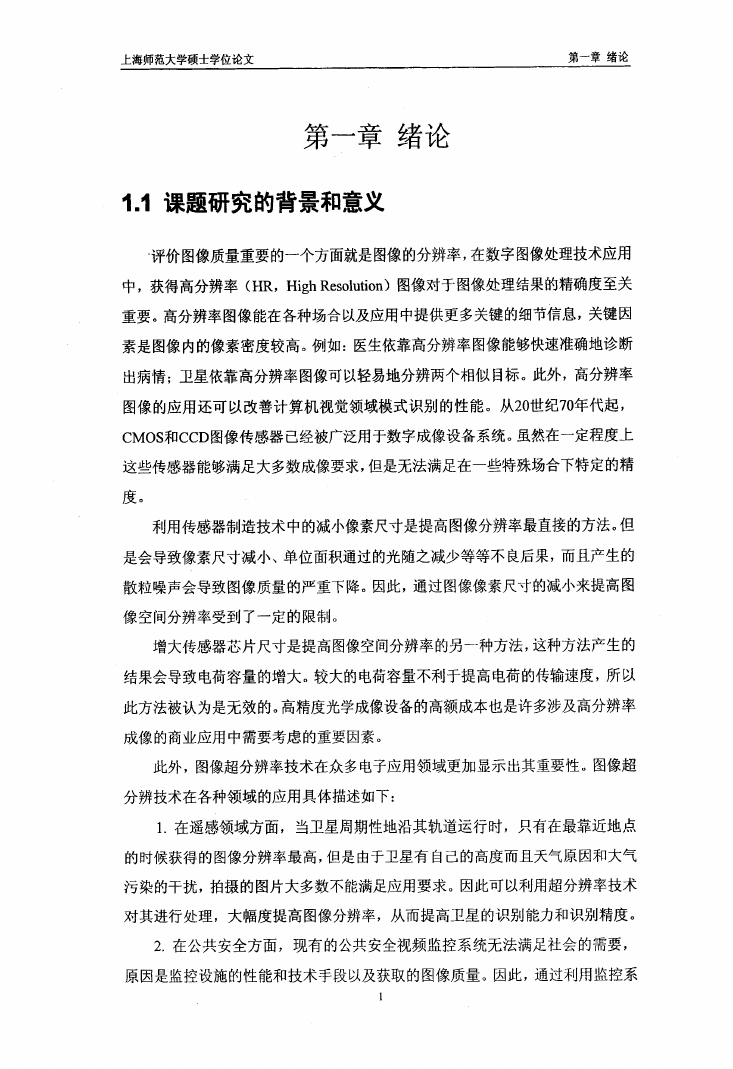








 2023年江西萍乡中考道德与法治真题及答案.doc
2023年江西萍乡中考道德与法治真题及答案.doc 2012年重庆南川中考生物真题及答案.doc
2012年重庆南川中考生物真题及答案.doc 2013年江西师范大学地理学综合及文艺理论基础考研真题.doc
2013年江西师范大学地理学综合及文艺理论基础考研真题.doc 2020年四川甘孜小升初语文真题及答案I卷.doc
2020年四川甘孜小升初语文真题及答案I卷.doc 2020年注册岩土工程师专业基础考试真题及答案.doc
2020年注册岩土工程师专业基础考试真题及答案.doc 2023-2024学年福建省厦门市九年级上学期数学月考试题及答案.doc
2023-2024学年福建省厦门市九年级上学期数学月考试题及答案.doc 2021-2022学年辽宁省沈阳市大东区九年级上学期语文期末试题及答案.doc
2021-2022学年辽宁省沈阳市大东区九年级上学期语文期末试题及答案.doc 2022-2023学年北京东城区初三第一学期物理期末试卷及答案.doc
2022-2023学年北京东城区初三第一学期物理期末试卷及答案.doc 2018上半年江西教师资格初中地理学科知识与教学能力真题及答案.doc
2018上半年江西教师资格初中地理学科知识与教学能力真题及答案.doc 2012年河北国家公务员申论考试真题及答案-省级.doc
2012年河北国家公务员申论考试真题及答案-省级.doc 2020-2021学年江苏省扬州市江都区邵樊片九年级上学期数学第一次质量检测试题及答案.doc
2020-2021学年江苏省扬州市江都区邵樊片九年级上学期数学第一次质量检测试题及答案.doc 2022下半年黑龙江教师资格证中学综合素质真题及答案.doc
2022下半年黑龙江教师资格证中学综合素质真题及答案.doc